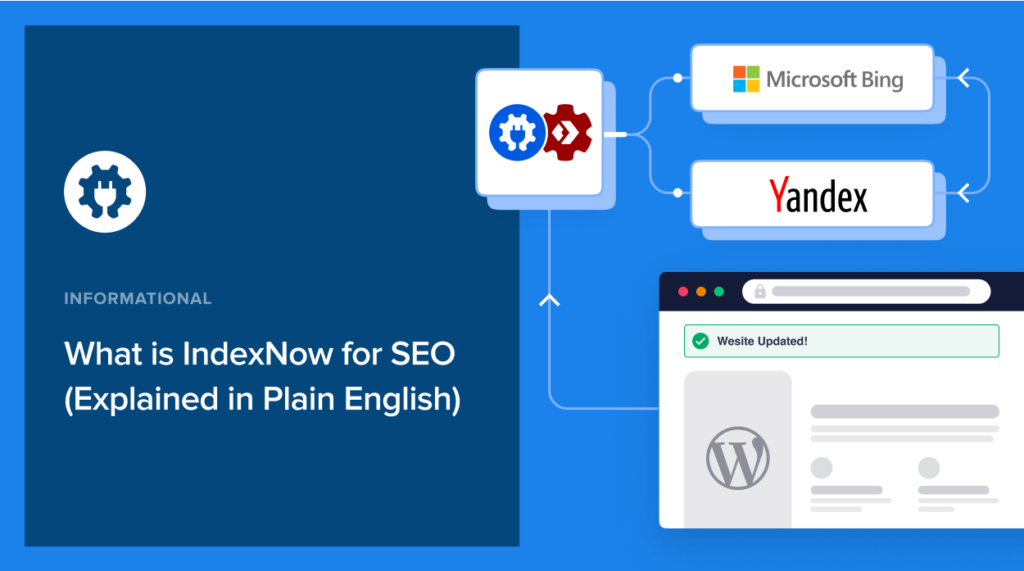What is IndexNow, and what’s all the hype around this protocol?
Search engine optimization (SEO) is a multifaceted discipline whose main aim is to rank high on search engine results pages (SERPs)
However, for your content to be considered for ranking by search engines, the first step is to get it indexed.
That’s where IndexNow comes in.
In This Article
What is Indexing (and Why is it Vital to SEO)?
Search engines have two primary functions, namely crawling and indexing.
Crawling is when search engines follow hyperlinks (URLs) to discover new content.
After search engines crawl (discover) a page, they index it. Indexing is the process of analyzing the content, media, tags, categories, and everything you’ve put on the page. Once they do this, the search engine stores this data in its database or index.
The time it takes for search engines to crawl and index your page can take anything from a couple of hours to months. Unfortunately, this means your SEO efforts for that page will only start kicking in after search engines index your page.
Thankfully, with AIOSEO you can easily check the index status of your posts and pages.
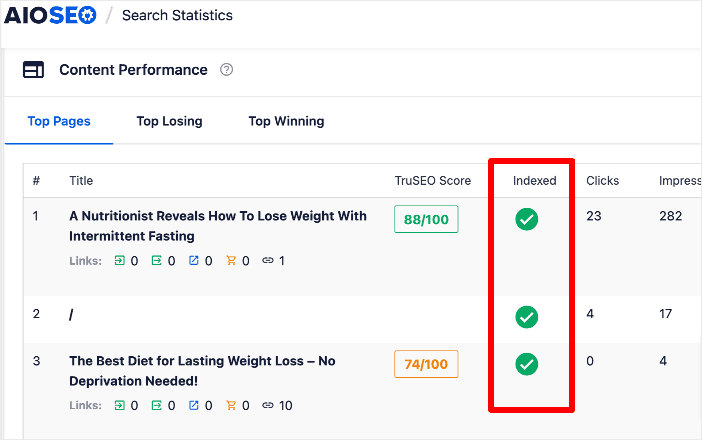
This will help you easily keep tabs on the index status of your pages.
To help give users a better experience online and ensure that searchers get the freshest content, Microsoft Bing, in conjunction with Yandex, launched the IndexNow protocol.
What is IndexNow (And How Does it Help with SEO)?
The IndexNow protocol makes the internet more efficient by instantly alerting participating search engines of any changes you make on your website. For example, if you change your content or add a new post or page, the IndexNow protocol will ping search engines about those changes. Doing so will result in the search engines crawling and indexing your changes faster.
For SEOs, one of the most significant efficiency gains is that the IndexNow protocol minimizes exploratory crawls and improves crawl efficiency. This results from the protocol alerting search engines of changes to your website.
Another significant advantage of IndexNow is that if one search engine participating in the IndexNow initiative is pinged, all other search engines will be alerted when new content is published. As a result, your content will quickly appear in search results for relevant searches.
How to Implement IndexNow on Your Website
Instant indexing is something SEOs worldwide have dreamed of for a long time. Finally, the IndexNow protocol has just made that dream a reality.
The million-dollar question is, “how do you implement IndexNow on your website?”
Here are the four easy steps to help you do that:
1. Generate API Key
An API key is needed to match the ownership of your domain with the URLs you submit for indexing. You can easily generate this key on Bing’s website.
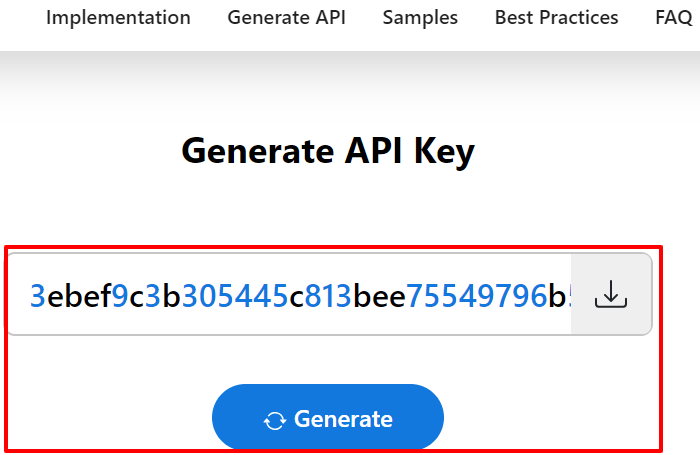
2. Host Your API Key
Once you have your API key, you must host it in .txt format on your website’s root directory. The easiest way to get the .txt file is by generating the API key by clicking the “Generate” button on Bing’s website. It gives you the option of downloading the API key as a .txt file.
Back to hosting the API key in your site’s root directory. The root directory of your website is the document file that holds all the files your website needs to function. You can find this in your hosting account’s cPanel in the “public_html” folder in the File Manager section:
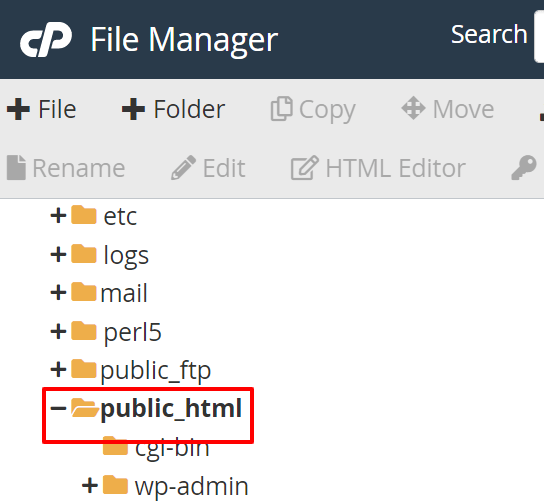
Create a text file (in an app like Notepad) and paste your API key into that file. Name your file using your API key. Once done, upload it to your root folder, and that’s it! You’ve hosted your API key.
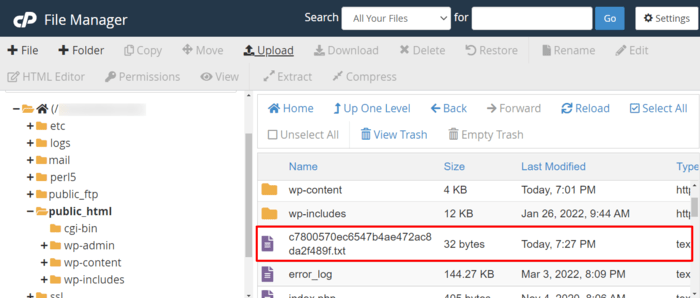
3. Submit Your URLs
You can submit individual or bulk URLs using your API key location as the URL parameter. Here’s a detailed guide on how to do so.
Get Details on the Status of URLs Submitted
Once you’ve submitted your URLs, you can check their status details in the Bing Webmaster Tools portal.

Note that you need to have an account to access the portal.
2 Easy Ways of Implementing IndexNow on Your WordPress Website
Does the process of implementing IndexNow sound complicated?
The above process can be quite a daunting task if you’re not technically inclined. Thankfully, there are some easier workarounds:
Implement IndexNow using AIOSEO
One of the easiest ways to implement IndexNow on a WordPress website is by using All In One SEO (AIOSEO).

Trusted by over 3 million websites, the SEO toolkit was designed to simplify search engine optimization for everyone — even those without a technical background. Notable features include:
- Cornerstone Content: Easily build topic clusters and enhance your topical authority and semantic SEO strategy.
- Search Statistics: This powerful Google Search Console integration lets you track your keyword rankings and see important SEO metrics with 1-click, and more.
- SEO Revisions: Track any changes you make to your site and see their impact on your SEO. Plus, you get to see on a timeline how Google updates affect your site.
- Advanced Robots.txt Generator: Easily generate and customize your robots.txt file for better crawling and indexing.
- TruSEO Highlighter: Makes it easy to spot on-page SEO issues and gives recommendations for fixing them.
- Next-gen Schema generator: This no-code schema generator enables users to generate and output any schema markup on your site.
- Redirection Manager: Helps you manage redirects and eliminate 404 errors, making it easier for search engines to crawl and index your site.
- Link Assistant: Powerful internal linking tool that automates building links between pages on your site. It also gives you an audit of outbound links.
- SEO Preview: This gives you an overview of your search and social snippets and general SEO so you can improve your optimization.
- IndexNow: For fast indexing on search engines that support the IndexNow protocol (like Bing and Yandex).
- Sitemap generator: Automatically generate different types of sitemaps to notify all search engines of any updates on your site.
- And more.
Once you have installed or updated AIOSEO on your site, you’ll find the IndexNow tool in the Features Manager section of your AIOSEO dashboard.
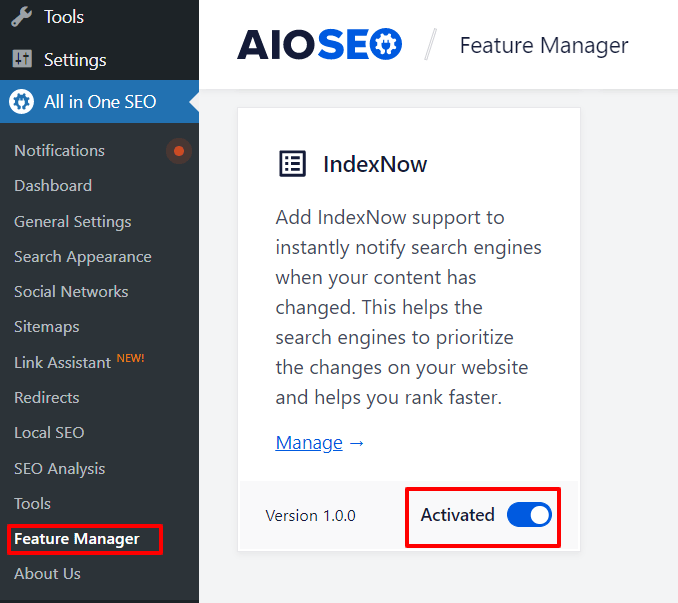
Once activated, you can automatically generate an API key and host it on your site. To do this, head over to the “General Settings” in the AIOSEO dashboard and click on the “Webmaster Tools” tab:

Click the “Save Changes” button at the bottom of the page, and that’s it! You’ve enabled IndexNow on your website.
Use Bing’s IndexNow Plugin
To help users easily access and implement the IndexNow protocol, Microsoft also created a plugin that makes it easier to implement IndexNow on WordPress websites. You can find the plugin in WordPress’s plugin directory.

The IndexNow Plugin for WordPress automates the submission of URLs from your site to every site participating in the IndexNow project. As a result, you don’t have to register and verify your site using the process described above.
Once you install the IndexNow plugin, it will automatically generate and host the API key on your website. It will also detect any changes to your content and automatically submit the URLs without any effort on your part.
The biggest advantage that AIOSEO has over the IndexNow Plugin for WordPress is that AIOSEO is a complete SEO toolkit. This means:
- You don’t have to add another plugin, thereby slowing your site down
- You can use the toolkit for many SEO-related tasks
For more details on activating IndexNow on your WordPress site, check out our how to add IndexNow to WordPress guide.
The bottom line is that implementing the IndexNow protocol is an important step you should take to boost your SEO results further.
IndexNow: Faster Indexing, Better Ranking Opportunities
The IndexNow protocol is the future of an open and transparent internet. Every SEO and web admin must take advantage of it to get SEO results faster and for your users to get a better experience. Both factors go a long way in helping you rank better.
We hope this post helped you understand what IndexNow is and why it’s important for your SEO. You may also want to check out other articles on our blog, like our top content optimization tools or our WordPress SEO cheat list.
If you found this article helpful, then please subscribe to our YouTube Channel. You’ll find many more helpful tutorials there. You can also follow us on X (Twitter), LinkedIn, or Facebook to stay in the loop.
Disclosure: Our content is reader-supported. This means if you click on some of our links, then we may earn a commission. We only recommend products that we believe will add value to our readers.
